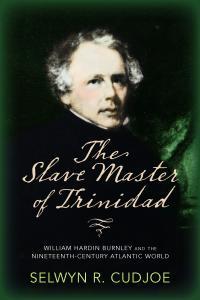Emancipation Foibles - Part 2
By Dr Selwyn R. Cudjoe
August 06, 2023
On June 27, 2022, Margaret Heath, a member of William Hardin Burnley's family who once owned the Orange Grove Sugar Estates, sent me an email. It read: "Dear Professor Cudjoe. I thought you might be interested to know that my brother, as executor of my mother's estate, has just informed me he consigned a trunkful of exclusive family papers that belong to William Hardin Burnley and his son, Frederick Burnley, to Paul Laidlow, Auctioneers, Carlisle, to be included in their sale on July 1st/2nd."
She described the contents of the papers. "It is an extremely large archive of documents pertaining to William Frederick Burnley and Company and the Burnley family during the 19th century, including diaries, correspondences, account records, and legal documents, records of business in the sugar plantation of Trinidad, etc."
I responded immediately, acknowledging my interest in purchasing the archive. I also asked Margaret why she thought I would be interested in the archives. She responded: "I bought your book about William Burnley some time ago, which I read with great interest, especially as to how it fitted in with what had been passed down to my mother about him, and about Augusta."
Augusta was Burnley's mistress with whom he had two children. He called them his "godchildren."
She continued: "Always referred to as 'THAT woman' whenever the subject came up in the family, at least that was what she was called in polite company. Her father was a wine (?) merchant in New York, with whom I am pretty sure William did shipping business, and a friend of William's. William visited them, and possibly stayed with them, whenever he was in New York."
Later that day Margaret wrote: "I talked to my sister, Belinda, who agreed with me that she also had many conversations with my mother about which archives would be the best for the Burnley papers, and Belinda wanted to tell you how glad she is that you are interested and the arrangement we had made. We can only hope no one else has spotted these are on sale."
I had asked Margaret to conduct the bidding for me since I only had three days to do so.
Unfortunately, someone else spotted the papers and outbid us at the auction. He contacted me subsequently for the same reason. He knew I was interested in the archives and sold it to me for close to $100,000 (TT). I now own the archive.
I bought this archive knowing that it belonged to the people of Trinidad and Tobago. It is not very often that such precious gems fall into one's hands. When people talk about "the right procedure," getting "someone who is old enough to say when they built the tunnel," and/or finding "the records of the original estates" in the British archives, I am not sure they know what they are talking about.
I am sure the British archives can still yield much information on Burnley's estate in Tacarigua. Over the past thirty years I have examined the Public Record Office at the National Archives (UK), the Watson Collection at Oxford University, Glasgow City Archives, the Mitchell Library, Glasgow, the National Library of Scotland in Edinburgh, the Library of Congress in Washington, and the West Indiana Collection at the University of the West Indies (St. Augustine). It takes patience and stamina to find the information McDowall and Beckles are looking for. McDowall postulates: "When the slaves were emancipated, all the slaves moved off the plantation, and the plantation owners only had a few years to accommodate the indentured people who were brought in. The owners demolished everything to make room for these people, who were working under different terms and conditions" (Newsday, July 27).
The slave masters did not have any a priori knowledge about the coming of the Indians. Burnley who advocated bringing them to work on the estates opposed the idea once the enslaved were freed. None of the early indentured Indians went to work on Orange Grove Estates.
The San Fernando Gazette in an editorial "Coolie Immigration," written on August 2, 1892, called Burnley "a slave driver" and noted: "Strange to say, Mr. Burnley was opposed to Coolie immigration. The Black population had been freed by the-as he thought-stupid philanthropy-of the Mother Country. But freed men must eat. His policy was to drive the emancipated slaves back to the cane fields by forcing them the alternative of starvation. Shut up the Crown Lands so close as to make it impossible for them to either squat on them or buy a morsel of them, and hunger would drive them to the Sugar estates."
All of my father's family, beginning with my great-grandfather, Jonathan (1833-1909), my grandfather, Robert James (1869-1963), my Uncle Hamilton, and my brother Winston Lionel (1940-85) worked at Orange Grove Estates. The Indians lived in "barracks" close to the factory under inhumane conditions. There was no "making way" for them by displacing the Africans. The Africans and the Indians eventually left the estates and formed villages along Eastern Main Road where they cultivated their provision gardens and plied their various trades.
In 1837 the Africans also built their own school, "the Cocoa House" (now St. Mary's Anglican School) which I attended. Alfonso Nurse, father of George Padmore, Joshua Stanley (of whom I am also writing), and Vernon Scott were headmasters there (See Slave Master of Trinidad, chapter 20.)
There is no white knight in shining armor who can tell us about ourselves. Much of the work has been done. One only has to start with examining the scholarship of people such as me to get a sense of William Hardin Burnley's life and the history of Tacarigua. It is the place to begin.
—Prof Cudjoe's e-mail address is scudjoe@wellesley.edu. He can be reached @ProfessorCudjoe.
Share your views here...

The Slave Master of Trinidad by Dr. Selwyn R. Cudjoe
|

